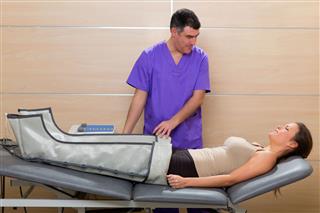
Arterial blockage in legs is a sign of peripheral artery disease, which is a medical condition characterized by narrowing of the vessels that carry blood to the leg and arm muscles. The following HealthHearty write-up provides information on the causes, symptoms, and treatment of blocked arteries in legs.
According to the Centers for Disease Control and Prevention (CDC), approximately 8 million people in the United States are affected by the peripheral artery disease (PAD). Arteries are blood vessels that carry oxygenated blood from the heart to various parts of the body. Blockage in arteries obstructs the free flow of oxygenated, nutrient-rich blood. As a result, blood enriched with oxygen and nutrients is unable to reach the tissues in the areas supplied by that artery. The tissues can get damaged in the event of restricted blood flow.
Peripheral artery disease is a condition wherein the arteries that supply blood to the arms and the legs become hard and constricted. Atherosclerosis is the major contributing factor for blocked arteries in legs.
Atherosclerosis and Peripheral Artery Disease
The oxygenated blood from the left ventricle of the heart is carried to various parts of the body by the aorta, which is the largest artery of the human body. The aorta bifurcates into two iliac arteries around the navel. These arteries transport blood into each leg. Near the groin, iliac arteries bifurcate into femoral arteries. The small branches of femoral arteries carry blood to the lower extremities. Peripheral artery disease occurs when the flow of blood is obstructed due to atherosclerosis.
Atherosclerosis refers to the hardening of the arteries due to the accumulation of plaque, which comprises cholesterol, fat, calcium, proteins, inflammatory cells, fibrin, cellular waste, etc. When plaque collects on the arterial walls, arteries become hard and constricted. Tissues get damaged as the arteries are unable to supply adequate amounts of oxygenated blood to the tissues and organs. Elevated levels of low-density lipoprotein (LDL) is one of the common reasons behind the development of plaque. Arterial plaque may accumulate faster in case of people affected by hypertension. Obesity, diabetes, and family history of vascular or coronary disease also puts one at a risk.
Buerger’s disease is another condition that is associated with blockage of arteries and veins in the arms and legs. It is characterized by swelling in the arteries and veins and formation of blood clots, which restrict the flow of blood to the arms and legs.
Symptoms of Peripheral Artery Disease
Since the leg muscles need larger amounts of oxygenated blood during physical activities, symptoms of peripheral artery disease are experienced while performing physical activities that require leg muscles to work. Here are some of the common symptoms of PAD.
- Claudication is a characteristic symptom of peripheral artery disease. It refers to intermittent pain and weakness in the calf, thigh, or hip muscle, that is usually felt while walking. Reduced blood flow causes cramps and pain, making it difficult to walk or exercise. The pain may initially be felt while walking uphill or walking for longer distances. The symptoms are relieved by rest, as the blood flow is sufficient while one is resting. In the advanced stages when the blood supply is greatly restricted, one may even experience pain while walking for shorter distances or even while resting.
- One may even develop thickened toenails or foot ulcers due to an inadequate supply of blood and oxygen to the tissues.
- If a person diagnosed with PAD suffers from an injury, he/she may take longer to recover due to the limited supply of blood.
- In severe cases, critical limb ischemia may occur. This is a condition where sores don’t heal, thereby causing a gangrene infection in the affected tissues.
- The symptoms of Buerger’s disease include claudication, Raynaud’s phenomenon, or development of painful open sores on fingers and toes.
Diagnosis
Peripheral artery disease often goes undetected, as many patients fail to recognize the symptoms. People who have a family history of vascular disease must seek medical help if they experience leg pain while walking. Tests that are conducted to diagnose this condition include:
- Arteriogram
- Duplex Arterial Imaging
- Ankle/brachial pressure index (comparison of blood pressure in the arm and the ankle)
- Treadmill Exercise Test
- PVR Waveform Analysis
- Computed tomographic angiography
Treatment Options
The treatment would involve treating the underlying cause. Lifestyle changes and drug therapy can prove beneficial in mild cases.
Drug Therapy
Thrombolytic therapy (administration of drugs into the arteries to dissolve the blood clots) might be recommended. ACE inhibitors or beta blockers are some of the drugs that may be prescribed to treat hypertension. Cilostazol, which is classified under platelet-aggregation inhibitors, might be prescribed in order to address the issue of intermittent claudication. It works by improving blood flow to the legs, thereby making it possible for the patient to walk farther before having to rest because of pain.
In severe cases wherein the conservative treatment options don’t work, doctors may recommend surgery for treating arterial blockage. The decision regarding the treatment option to be used would be made after analyzing the nature and extent of blockage. The following procedures might be recommended:
Angioplasty and Stenting
Angioplasty might be performed to open the clogged arteries. This procedure involves the insertion of a small balloon-tipped catheter through a blood vessel to the blocked artery. This balloon is then inflated to compress the plaque buildup into the arterial wall. The objective is to widen the constricted artery so as to increase the flow of blood. Your doctor may also insert a slender tube or a stent in the artery. While the balloon is inflated, the stent stretches up to the size of the artery. The balloon is then deflated and removed, while the stent remains in place to keep the artery open.
Bypass Surgery
Bypass surgery is considered to be quite effective for extensive blockage in leg arteries. In this surgery, a new path is created using an unblocked blood vessel or an artificial tube so that blood can flow to the targeted area. The bypass is attached above and below the area that is blocked.
Endarterectomy
Endarterectomy is a procedure wherein an incision is made in the affected leg for the removal of plaque from the inner walls of the affected leg artery. The blood flow is restored as the plaque deposits that were constricting the artery are removed.
Only in extreme cases, where gangrene is observed, and the aforementioned surgical procedures will not work, amputation is recommended. While surgical procedures may help in removing plaque deposits, it is equally important to make lifestyle-related changes to prevent the accumulation of fatty deposits in the arteries. Maintaining healthy body weight and keeping blood sugar and blood pressure levels in check will certainly prove beneficial. Following a healthy diet and exercise regimen will also help keep the cholesterol levels within the normal range. Do keep in mind that smoking and alcohol abuse are risk factors for several serious medical conditions. So, make the necessary lifestyle-related changes, and religiously follow the guidelines given by your doctor to prevent serious complications from arising.
Disclaimer: This HealthHearty article is for informative purposes only, and should not be used as a replacement for expert medical advice.











